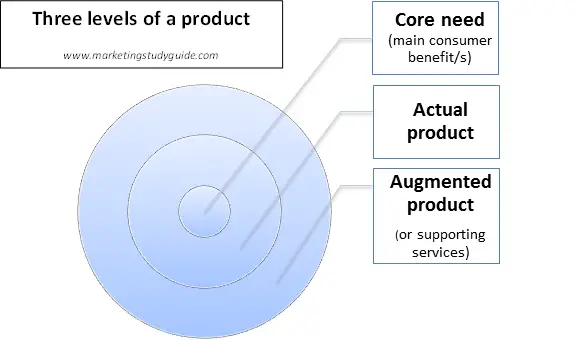Contents
What is Product Augmentation?
The definition of the word augmentation means to make larger or to expand.
In marketing terms, product augmentation is a set of associated services and other benefits that are provided to a consumer in addition to the actual product that they are purchasing.
That is, product augmentation is anything that adds value to the customer OUTSIDE of the actual product design and its product features. In most cases, the product is product through additional services or information.
Two Approaches to the Product Level Models
Depending upon your level of study in which marketing textbook you are using, you will be either reviewing the three product level or the five product level diagram of a product.
Typically, in most textbooks, they refer to the three product level, which is generally structured as:
- The core product or underlying need
- The actual product
- The augmented product
However, in some more advanced marketing textbooks, they expand into the five product levels as follows:
- The core benefit
- The actual product
- The expected product
- The augmented product and
- The potential product
As you can see, they add what consumers “expect” from a product in that category, as well as outlining how the product is likely to grow and develop over time = the potential product in the future.
Please refer to the articles on the three product level model in the five product level model available on this website for more information.
The Key Goal of Product Augmentation
Product augmentation allows marketers to differentiate their product more clearly in the marketplace. This can be especially important to fairly generic type products, such as breakfast cereals, loaves of bread, and commonly used software.
In each of these cases, it may be difficult to generate a significant competitive advantage through the product design only – and product augmentation provides the opportunity to deliver additional benefits to the consumer that may generate additional market share.
The other advantage of product augmentation is that many of the additional services are relatively inexpensive to provide and do not overly add to the unit costs. Therefore, the overall product offering may be seen as having significant value, without a significant underlying cost structure.
Advantages of Product Augmentation
A key opportunity to differentiate a product in the marketplace is by augmenting the product.
Augmentation, which is primarily designed to deliver competitive differentiation, should hopefully provide the brand/firm with:
- Clear positioning in the marketplace
- Unique product features/benefits
- A strong competitive competitive advantage
- Stronger appeal to certain target markets
- Willingness for consumers to pay a price premium
- Customer loyalty, as they become accustomed to the additional value
- Additional price margins, if the augmentation provided is relatively low cost
Examples of Product Augmentation
Here is a 50+ list of some potential ways and ideas that a product can be augmented. Please note that these augmentation ideas may or may not be appropriate for all categories of products…
- Providing a free replacement of the product
- Having a warranty period for repairs
- Having recipe ideas on the packaging
- Having a QR code on the packaging
- Having a code to access free online games
- Having a discount coupon for a future purchase
- Having interesting information on the packaging
- Donating a percentage of the sale to a charity
- Having a loyalty program
- Access to special events
- Newsletters and information sheets
- Free seminars
- Free advice
- In-store entertainment
- Priority ordering
- Priority queuing or seating
- Early access to new products
- Future price guarantees
- Access to a relationship manager
- Free gifts
- Hospitality and events
- Free coffee/snacks in a store
- Online product support
- Free delivery
- After sales follow-up
- Ability to package purchases (bulk deals)
- Financing the purchase
- A free trial period
- Some form of a customer club
- Online customer-firm interaction
- Friendly, efficient customer service
- Restroom facilities
- Online information/support
- Updates on new products
- Future special offers
- Future discounts and coupons
- Free product upgrades in the future
- Bundling products and services together – a phone with apps
- Adding AI technology to existing software, such as Microsoft Word
- Brands that support charities and social causes = brand goodwill
- Ongoing newsletters, notifications, special information
- Ability to tailor and customize product design to the consumer’s preference
- Ongoing subscription services to regular products
- Companies who organize product disposal, such as taking away an old washing machine for free
- Offering in-store demonstrations, courses, interactions, information
- Online forums, webinars, and other shared information
- Engagement in co-creation of future products
- Packaging information or product information in different languages
- Gamification tools
- Virtual reality experiences while shopping or online
- Price guarantees
- Easy refunds, or money back guarantees, or trial periods
- Easy integration with other products
RELATED TOPICS
The three level product model
The five level product model

